|
Blue and White for Everyday
by
Bob Brooke
By the last quarter of the 18th century,
the market for blue and white ware had grown. While it had been only
seen on the dining tables of the wealthier class, it began to appear in
the homes of merchants and bankers. No longer would it be delegated for
use on special occasions, for a new less expensive version appeared in
the shops. Now potters could make more pieces for less using the then
innovative transfer process.
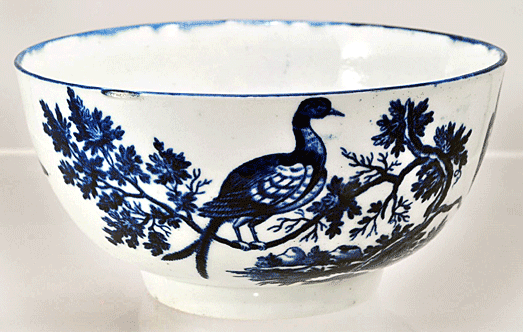
The Transfer Process
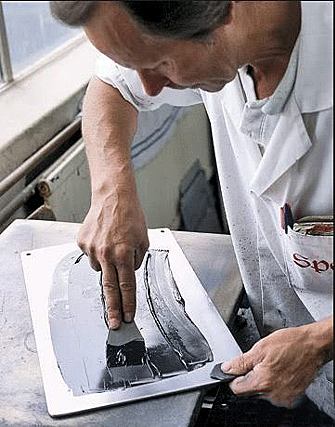 Most
blue and white ware made in England after the mid-1780s was transfer
printed from hand-engraved copper plates onto white earthenware. The
production of a blue print began with a design on paper. The engraver
traced the outline onto thin tissue paper and then reproduced it on a
sheet of copper using homemade carbon paper. He engraved over this
outline with a V-shaped groove and added the details and areas of
shading using lines or dots. The idea of using dots, or stipple
punching, rather than lines came later in the 18th century. The engraver
found the right depth by trial and error, so he took a first print or
proof before he reworked the lines and dots to deepen them if necessary.
The deeper the engraving, the deeper the deposits of color, thus the
darker the result. Early prints were mostly engraved with lines and in
uniform dark blue, but as the technique of engraving improved so
engravers achieved different tonal qualities. Most
blue and white ware made in England after the mid-1780s was transfer
printed from hand-engraved copper plates onto white earthenware. The
production of a blue print began with a design on paper. The engraver
traced the outline onto thin tissue paper and then reproduced it on a
sheet of copper using homemade carbon paper. He engraved over this
outline with a V-shaped groove and added the details and areas of
shading using lines or dots. The idea of using dots, or stipple
punching, rather than lines came later in the 18th century. The engraver
found the right depth by trial and error, so he took a first print or
proof before he reworked the lines and dots to deepen them if necessary.
The deeper the engraving, the deeper the deposits of color, thus the
darker the result. Early prints were mostly engraved with lines and in
uniform dark blue, but as the technique of engraving improved so
engravers achieved different tonal qualities.
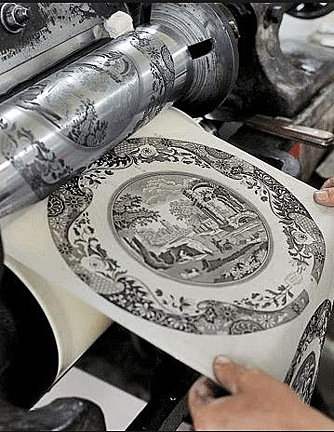 The
next step was printing. A circular iron plate or backstone kept the
color—a mixture of metallic oxides and fluxes with printing oils—warm.
The printer applied this to the copper plate, which he kept hot on the
hot plate, making sure to rub color into every dot and line. The surplus
was then scraped off. He removed any film of color by bossing the
surface with a corduroy-faced pad. After the copper plate was clean, he
laid the tissue paper coated with a mixture of soft soap and water and
passed it through the press’s rollers. He then passed the printed image,
now in reverse—unlike regular engravings that begin in reverse and
appear correct on printing—on to the transfer team, consisting of the
transferrer, apprentice, and cutter. The
next step was printing. A circular iron plate or backstone kept the
color—a mixture of metallic oxides and fluxes with printing oils—warm.
The printer applied this to the copper plate, which he kept hot on the
hot plate, making sure to rub color into every dot and line. The surplus
was then scraped off. He removed any film of color by bossing the
surface with a corduroy-faced pad. After the copper plate was clean, he
laid the tissue paper coated with a mixture of soft soap and water and
passed it through the press’s rollers. He then passed the printed image,
now in reverse—unlike regular engravings that begin in reverse and
appear correct on printing—on to the transfer team, consisting of the
transferrer, apprentice, and cutter.
The cutter removed the excess paper leaving only the design pieces. The
transferrer laid
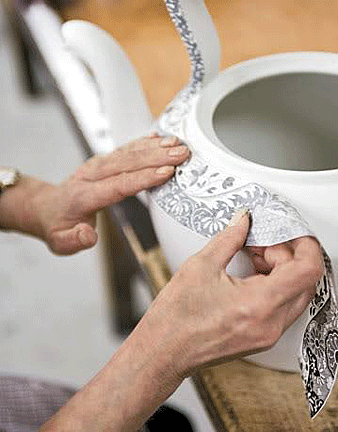 these
pieces, colored by cobalt oxide, on to the ware after its first or
biscuit firing, then dipped it in glaze and refired it, where the silica
in the glaze helped to convert black cobalt oxide to blue cobalt
silicate. A design with an overall pattern would have the center applied
first and the border around the rim afterwards. The tackiness of the
oily print held it in place while the apprentice rubbed it down
vigorously with a stiff-bristled brush using a little soft soap as
lubricant. these
pieces, colored by cobalt oxide, on to the ware after its first or
biscuit firing, then dipped it in glaze and refired it, where the silica
in the glaze helped to convert black cobalt oxide to blue cobalt
silicate. A design with an overall pattern would have the center applied
first and the border around the rim afterwards. The tackiness of the
oily print held it in place while the apprentice rubbed it down
vigorously with a stiff-bristled brush using a little soft soap as
lubricant.
The apprentice then soaked the earthenware in a tub of water to soften
the paper which was removed by sponging, the oil-based color being
unaffected by the water. After drying, an assistant placed the ware into
the hardening kiln to fire at 1,250-1,290 F. to remove the oils and
secure the color. Afterwards, the ware was glazed and refired at
1,940-2,010 F. Sometimes the dark blue diffused or flowed beyond the
lines of the pattern because of overglazing or overfiring, thus the term
flow blue.
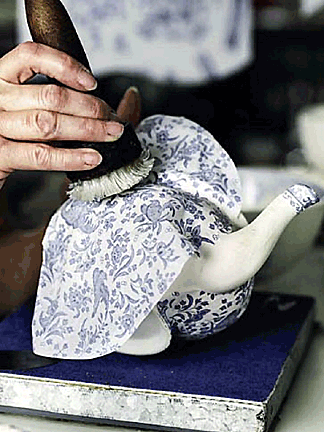 Engraving
for transfer printing reached its zenith by 1816. And by 1805, lighter
shades of royal blue as well as ultramarine came into use. Though each
factory developed its own potting and decorative techniques,
considerable copying took place between factories. In addition, each
factory experimented with different styles and products changed
dramatically over a short time. Engraving
for transfer printing reached its zenith by 1816. And by 1805, lighter
shades of royal blue as well as ultramarine came into use. Though each
factory developed its own potting and decorative techniques,
considerable copying took place between factories. In addition, each
factory experimented with different styles and products changed
dramatically over a short time.
Not only did the paste and tone of the under-glaze blue vary from
factory to factory, but they also varied according to the stage of each
factory’s development. Sound confusing? It is.
Patterns Decorating the Wares
To complicate matters, makers constantly introduced new patterns, while
shapes of plates, dishes, tureens varied from time to time according to
the prevailing trends. When the Chinese-inspired designs lost favor,
manufacturers replaced them with European scenes, which they copied from
engravings in books. Floral borders resembled each other in general
appearance, although most differed in detail.
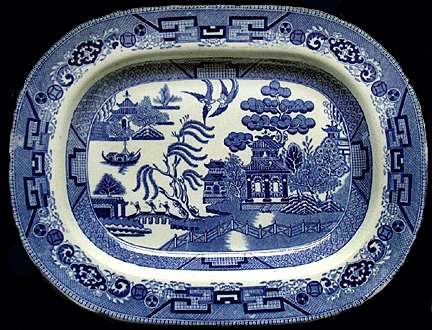 Most
patterns of Chinese blue and white wares are of purely Chinese origin.
The Chinese painter, whether treating natural or contrived subjects,
followed conventions set down in artist and calligraphic manuals. The
British copied the Chinese patterns faithfully. One of these, called
Mandarin, led to the creation of the Willow pattern. The original
Chinese patterns were widely distributed, judging from the large number
of examples found today. Four Chinese patterns seem to have been more
popular than others--Mandarin, Temple-Landscape, Two Temples and Rock. Most
patterns of Chinese blue and white wares are of purely Chinese origin.
The Chinese painter, whether treating natural or contrived subjects,
followed conventions set down in artist and calligraphic manuals. The
British copied the Chinese patterns faithfully. One of these, called
Mandarin, led to the creation of the Willow pattern. The original
Chinese patterns were widely distributed, judging from the large number
of examples found today. Four Chinese patterns seem to have been more
popular than others--Mandarin, Temple-Landscape, Two Temples and Rock.
Perhaps it was the lack of human interest in these original patterns
that prompted Spode to add features which he derived from other Chinese
landscapes. He added the bridge with three people leading to a pavilion
and a fence across the foreground, for example. He also changed the
appearance of the tea house to make it more like the original Chinese
design.
While collectors of blue and white may not be looking for Chinese
porcelain, they’re likely to come across many English copies, especially
of Two Temples, which is also called Temple, Brosley or, incorrectly,
Pagoda. However many of the manufacturers didn’t mark their products so
these pieces often remain unidentified.
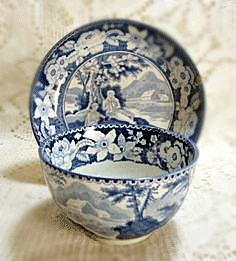 Identifying
blue and white ware can be tricky. Because many examples of blue and
white weren’t marked with the manufacturer’s name, attributing a certain
design to a particular manufacturer is often impossible. It’s likely
that these duplications came about because independent engravers sold
sets of copper plates of the same pattern to several manufacturers who
were unconcerned with exclusivity. Identifying
blue and white ware can be tricky. Because many examples of blue and
white weren’t marked with the manufacturer’s name, attributing a certain
design to a particular manufacturer is often impossible. It’s likely
that these duplications came about because independent engravers sold
sets of copper plates of the same pattern to several manufacturers who
were unconcerned with exclusivity.
Confusion occurs when one firms’s pattern appears on another’s marked
pieces. It’s possible that the original maker bought undecorated but
marked biscuit ware from a second manufacturer when he had an
insufficient supply to complete an order.
Around 1830, designs changed to a more open style. Instead of having
bold borders of flowers on a stippled background, the content become
lighter, with sprays of smaller flower and no background stipple
punching. The center designs also became smaller, with much white space
surrounding them. Scenes were often romantic, with strolling figures in
Italianate or pseudo-Oriental gardens beside a lake, or views of rivers
with castles.
Marks Used on Transfer Wares
Marks can be misleading, however, and should be taken into consideration
only after all the features of the piece have been appraised. Marks such
as initials, symbols and names may be impressed, incised, printed, or
painted and may relate to the manufacturer, factory, workman or even the
retailer.
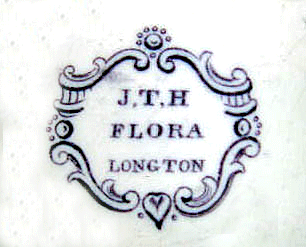 Before
1872, for example, when a workman was paid on the “good from oven”
principle, he applied his own mark since it was important that his
output of ware be identified so that he could be paid. These marks were
simple and workmen in other factories might have used the same marks
such as a rough flower shape, an oblique line, or a cross within a
circle. However, these marks have little bearing on identifying a piece
as being from a certain manufacturer, because workmen often moved from
one factory to another when their contracts ran out. Before
1872, for example, when a workman was paid on the “good from oven”
principle, he applied his own mark since it was important that his
output of ware be identified so that he could be paid. These marks were
simple and workmen in other factories might have used the same marks
such as a rough flower shape, an oblique line, or a cross within a
circle. However, these marks have little bearing on identifying a piece
as being from a certain manufacturer, because workmen often moved from
one factory to another when their contracts ran out.
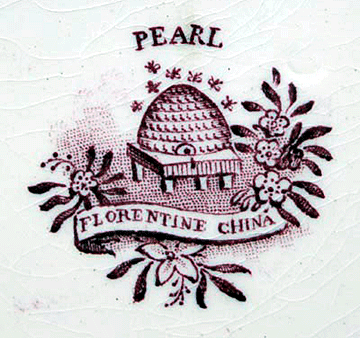 English
historic pieces are usually marked with the name of factory and/or
scene. Some of the leading makers included Clews, Stevenson, Enoch Wood,
William Adams, Ridgeway, Riley, Thomas Minton, Josiah Spode, and
Davenport. Plates can also be identified by their borders—spear,
butterfly, floral, and brocade. This isn’t only true of Chinese blue and
white ware, but also with English blue and white transfer ware from 1815
on. However, it was quite common for a pleasing border or center pattern
to be copied and used by several manufacturers. English
historic pieces are usually marked with the name of factory and/or
scene. Some of the leading makers included Clews, Stevenson, Enoch Wood,
William Adams, Ridgeway, Riley, Thomas Minton, Josiah Spode, and
Davenport. Plates can also be identified by their borders—spear,
butterfly, floral, and brocade. This isn’t only true of Chinese blue and
white ware, but also with English blue and white transfer ware from 1815
on. However, it was quite common for a pleasing border or center pattern
to be copied and used by several manufacturers.
While some collectors concentrate on a single pattern, others go the
eclectic route, collecting whatever fancies them in blue and white.
Collecting may follow a theme such as those pieces from one manufacturer
such as Copeland or Spode or possibly just Chinese landscapes, or floral
designs. In the U.S., flow blue and American scenery are two dominant
themes.
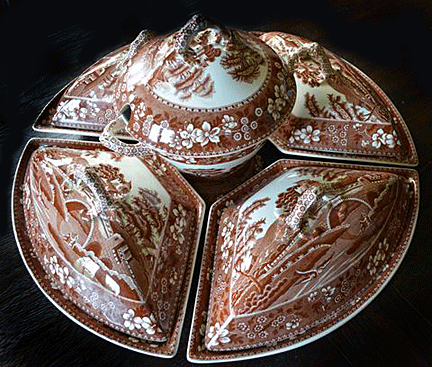 Manufacturers
made most blue and white into dinnerware, and sometimes, toiletware.
Occasionally, teawares can be found but because it broke more often,
little has survived. Dinnerware produced until 1825 consisted of 9½
-inch dinner plates, 8-inch pudding plates, Manufacturers
made most blue and white into dinnerware, and sometimes, toiletware.
Occasionally, teawares can be found but because it broke more often,
little has survived. Dinnerware produced until 1825 consisted of 9½
-inch dinner plates, 8-inch pudding plates,
9½-inch soup bowls, plus meat dishes and platters in many sizes, as well
as covered vegetable dishes, sauce boats, tureens and stands, and
perhaps a supper set, comprised of a wooden tray with four covered
fan-shaped sections surrounding a central tureen to hold a sauce or
boiled eggs. Complete sets are rare. Members of the household used
supper sets for a self-service meal late in the evening after the
servants had gone to bed. In those days, dinnerware didn’t include side
or bread and butter plates but often had twice as many dinner plates.
Other favorite items included fruit baskets and stands, often with
pierced borders, especially with plates having pierced arcaded borders
with embossed wicker work.
Scenic patterned sets may be divided into three groups--those with the
same scene depicted on every object, as in Spode’s Blue Italian or Tower
pattern and Wild Rose, made by more than a dozen firms; a multi-subject
pattern with a different study on each size of plate and each different
item, as in British scenery by an unidentified maker; and a
multi-subject set of 12 dinner places, as the Don Pottery’s Named
Italian Views.
<
Back to Antiques Archives
Next Article > |
